Lunch with... Tom Kristensen
He won Le Mans at his first attempt, and has barely been off the podium since then. Little wonder the Dane’s passion for La Sarthe still shines through
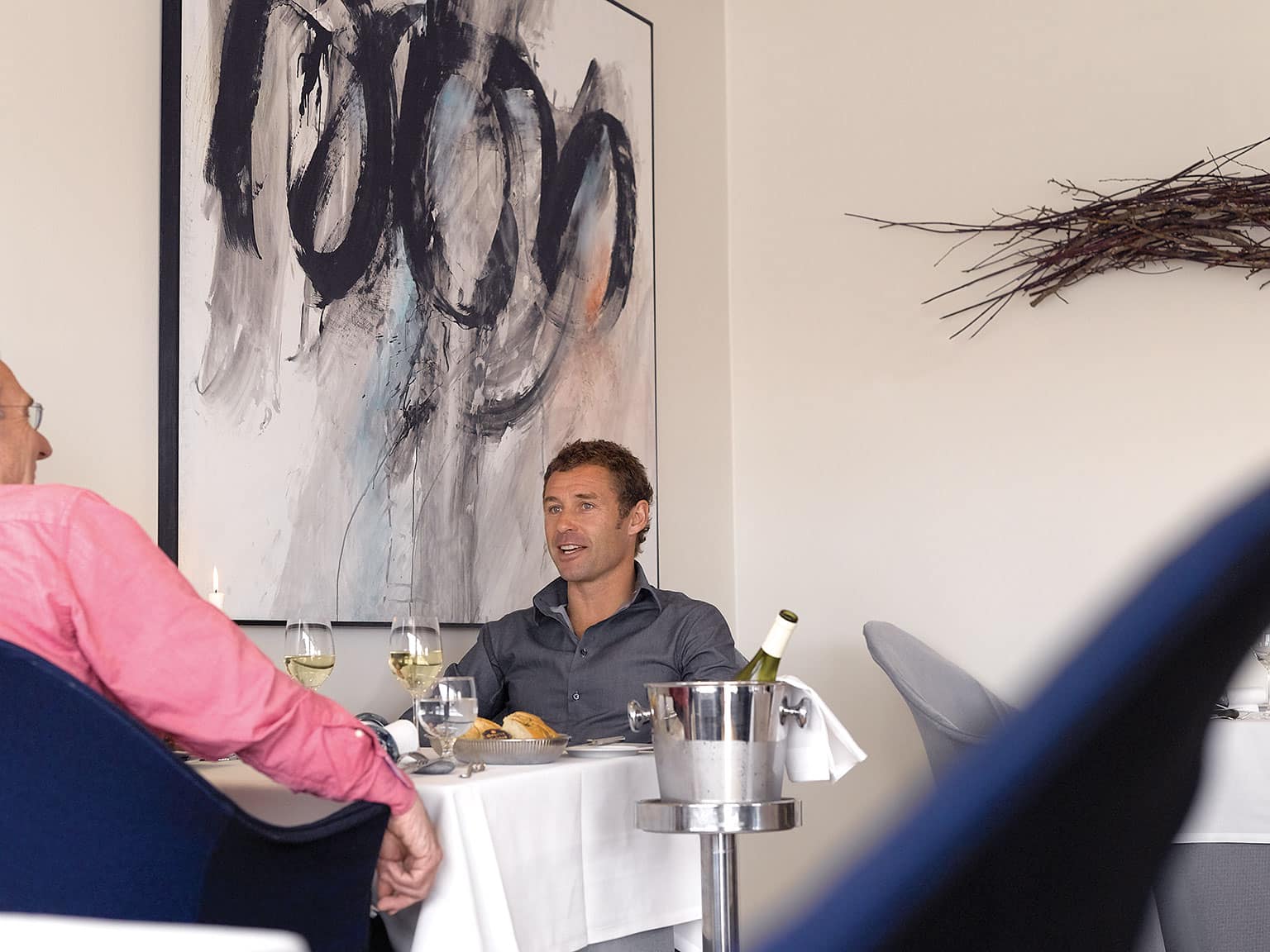
Le Mans is an extraordinary motor race, and to conquer it takes an extraordinary mix of abilities. Physical fitness and stamina, of course, and high levels of cockpit concentration, often in dramatically changing conditions. And, nowadays, real ten-tenths speed, day and night, hour after hour. Personal discipline too, allied to an unselfish team spirit, and the ability to work under intense pressure with a tightly motivated group of individuals. Plus all the other attributes of a top racing driver – but with some of them in greater supply than even Formula 1 requires.
Thus, to win Le Mans even once is a signal achievement. To win it eight times indicates a truly exceptional talent. Only Tom Kristensen has done this. In 1997 he was an F3000 driver, leading the European championship and knocking on the door of F1, when at a few days’ notice he was summoned to Le Mans for the first time. Having never sat in the car before, he won, and set a record fastest lap during the night. Over the next 11 years he went on to win the 24 Hours seven more times. This month he is back, looking for win number nine.
Denmark is a mainly rural country of just 5.5 million people. Tom was born 42 years ago in the small northern town of Hobro, in a flat over his father’s little garage business. Today, every inch the professional racer, he lives in Monaco. But to relax he likes to spend time with his young family in his holiday house on the North Jutland coast at Skagen. We meet there, and lunch is at the 100-year-old Ruth’s Hotel, a stone’s throw from the sea. It’s known for its dramatic cuisine, but Tom’s fare is healthy: asparagus, local scallops, fresh fruit, a tiny sip of white wine.
“My dad was a big influence on me. He was into hot rod racing and rallycross, even a bit of circuit racing. But money was tight, so he was always struggling with bad equipment. He’d work hard all day and work on his race car all night, and his enthusiasm came across to me. From when I was six I used to go with him. At first I was more interested in stickers to add to my collection, but even then I was aware of the friendship, the paddock camaraderie.”
By the age of 10 Tom was karting, and showing real ability. Soon he was clocking up Danish junior titles, and in 1985, aged 18, he was Scandinavian Kart Champion. Second that year was a Finn by the name of Häkkinen. He won the Italian title, finished second in the European Championship, and in 1987 he was second in the World Championship. “It was good for me, racing against karters like Mika, Alex Zanardi, Yvan Muller, Gianni Morbidelli, Vincenzo Sospiri, Christian Fittipaldi. I could only do it because a lot of good people helped me with my travel and equipment costs. Denmark is a small country, and I am so grateful for the support I had.
“But I could not afford to go on. My mother said 99 out of 100 people who try to work in motor sport never get anywhere, and I should have a proper job. Of course, I was hoping to be the one, not the 99, but she persuaded me to get a job in a local bank as a trainee. I didn’t dislike it, but it wasn’t the aim of my life. I read the English racing magazines every week and I called people up, trying to chase every idea, every opportunity. I had the odd drive in FF2000, and in the end Bertram Schäfer took me on for his 1991 German F3 team.” Tom was expected to be the number two in the Ralt-VW outfit, but in his first race, at Zolder, he won from pole and set fastest lap. He went on to win the German championship. Opportunities for a fast young man with no budget were still hard to find, but at the end of the season he got a ride at the prestigious F3 race at Macau.

A BTCC outing for Honda at Croft in 2000
Motorsport Images
“I loved that place, a real road circuit. I arrived with [fellow Dane] Kurt Thiim, full of jet lag, but at 4am the rickshaws were busy taking the drunks home. So we took a rickshaw round the track and I learned it that way. And I was fastest in first practice. It didn’t count for the grid, of course, but you remember these things.” Tom qualified fifth and finished sixth. A week later he did the Fuji F3 race, and was running third in the closing stages when he ran out of fuel. That was when Toyota approached him with an offer to race in Japan.
“I stayed in Japan for five seasons. In F3 I won the Japanese championship and the World Final at Fuji, and I was second at Macau. In touring cars I was twice runner-up in the championship, and I also raced the Nissan Skylines, which had huge power. I did two seasons of Formula Nippon [Japanese Formula 3000], and came second in the championship in 1995. I did a lot of racing. Most Europeans still underestimate the whole Japanese racing scene. It’s very professional – a lot of circuits, a lot of people involved, a big industry. The Japanese are incredibly passionate about their racing. And I earned good money. When I went home for Christmas my mother still said, ‘When are you going to get a proper job?’ I had to tell her I was earning more than I’d be earning in the bank.
“I raced the Supra GT car for Toyota and the V10 Group C car too, with Eddie Irvine and Jacques Villeneuve. Eddie was well established in Japan, and much respected. He was always direct and straight to the point, which I liked, but very business-orientated about his racing. I didn’t see so much passion, which was a little bit difficult for me to understand. Jacques, I have a lot of good memories of him. We’d raced together since Japanese F3. He didn’t look like a racing driver, long hair, little round glasses. He didn’t behave like one either. But it was in Japan that he found out, ‘I can do this, I am fast.’ I was very focused on my racing, but Jacques was into his music. He couldn’t pass a music shop without going in and coming out with a pile of CDs. He had a ground-floor apartment in Tokyo and all it seemed to have in it was a huge American fridge and a huge sound system, not even any curtains. I remember going with him by train to a circuit in the south of Japan for a test. Jacques knew where we were going, but his ears were plugged into his music as usual, and we ended up in the wrong place. It was late, the last trains had run, so we had to find a hotel room. We ended up having to share a bed. I don’t know what the people in the hotel thought. We turned up late for the test next day.
“My mentor in Japan was Kazuyoshi Hoshino. Very fast, very calm, didn’t say much, but we had great chemistry when we raced together. Just a great guy. There have been quite a few good Japanese drivers on the international stage, but if you ask any of them who was the best, I think they’d say Hoshino.”
In 1996 Tom returned home, determined to make his mark in European F3000. The first team he drove for folded mid-season, after which Peter Briggs gave him what drives he could for Edenbridge, but pole positions at Spa and Pau and second place at Silverstone showed his potential. Then Bettenhausen offered an Indycar test. “It was between Jörg Müller, Allan McNish, Patrick Carpentier and myself. It was all very professional, two sets of soft tyres each, and I was fastest, on both my sets. I was hoping to get the drive, but I didn’t hear any more, and it went to Carpentier. It’s the way things happen.
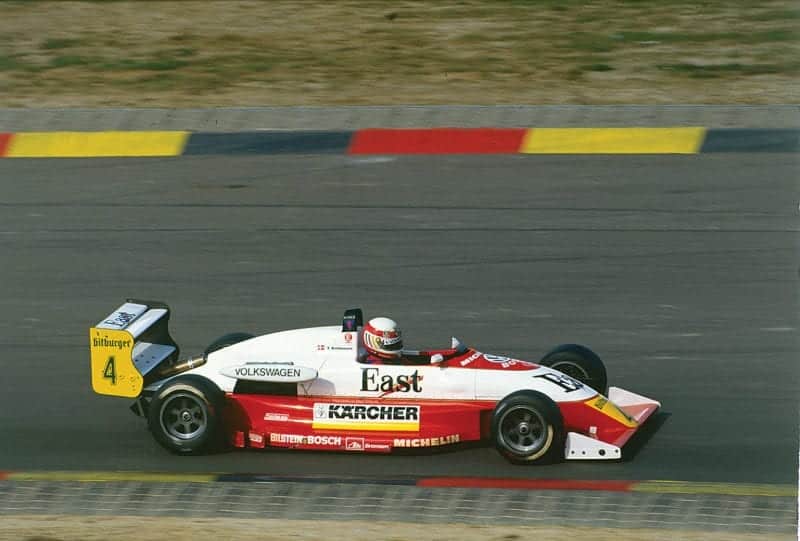
Kristensen won German F3 title at first try in Ralt-VW in 1991
Motorsport Images
“So it was F3000 again in 1997, and after the first three rounds I was leading the series. Then the week before Le Mans, on the Thursday, I got a call from Ralf Jüttner of Joest Racing. They were running a Porsche with Michele Alboreto and Stefan Johansson, and at the last minute they thought of me for the third seat. Everything happened very fast. I flew to Germany next day. The car and most of the mechanics had already left for Le Mans, but sitting on the workshop floor was a spare monocoque, and Jürgen Hördt suggested I get in and try it. I wriggled into the seat and I said, ‘It’s fine, it fits me very well.’ Then, starting to feel at home, I said, ‘Maybe if the brake could be just a fraction closer, it would be perfect.’ And old Jürgen put his head down to me in the cockpit and said, ‘Das schnellste bestimmt bei uns’ – with us, the fastest driver decides that. That put me in my place.
“But they gave me the drive. I went to Le Mans, and had just 18 laps in the car in practice, including in and out laps. And we won. Michele and Stefan were so good to me, very open. Michele knew the car well, so I spent a lot of time with him. We went together on a scooter and looked at parts of the track, and I asked him about lines and gearchange points. He never told me what to do, but when I asked questions he always gave me good answers. He gave me confidence. Michele was such a good guy.
“And during the night I happened to set a few quick laps, which was nice. It was getting towards what we call Happy Hour at Le Mans: it’s just starting to get light, so visibility is better, but it’s still cool, so you can run a relatively soft tyre compound and the air density is good. I was still learning, getting better as the race went on. We were doing 50-minute stints between fuel stops, and the rules allow you to stay in the car for up to four hours, so I was on my third stint and the tyres were still good. Jüttner came on the radio and said, ‘Fastest lap, well done. Keep the pace.’ That meant: don’t go slower, don’t go faster. Three laps later he came on again, and told me I had beaten my new record. That was 3min 45sec, which was the fastest lap of the race. Then, because the tyres seemed OK, he said, ‘Tom, can you do another stint?’ Of course I said, ‘Yes, no problem.’ In fact I was completely knackered. It was my first Le Mans and I was concentrating so hard, even on the straights. Back then there was no power steering, no paddle-shift: you shifted with your left hand, a good old Porsche ’box, very strong, but heavy. But they’d given me this chance, and I wanted to pay them back. So I was in the car through the night for three hours 20 minutes. Nowadays at Audi it’s quite usual to do four stints.
“I still had my heart set on Formula 1. I tested for BAR and Minardi – they offered me half a season if I could come up with some money, which I couldn’t, and so for 1998 I signed with BMW, who were developing their new Le Mans car with Williams. I had a good relationship with Williams, and got on very well with Patrick Head. I hoped it might lead to something, and I tested the F1 car. But they had Zanardi, Ralf Schumacher, suddenly there was Montoya, Button, Junqueira, Jörg Müller, so it didn’t work out.”
The BMW V12 LM had barely run when the teams went to the May pre-qualifying weekend. “It was only the second time I’d been at Le Mans, and that was when I had my worst scare. On the fast stretch between Mulsanne Corner and Indianapolis, suddenly I had no steering. At around 200mph I was on the grass. I braked with my left foot and managed to keep the car out of the barriers, got back onto the Tarmac, drove back to the pits and said, ‘I think I have a rear puncture, or some sort of aero problem.’ They couldn’t find anything wrong, and my team-mates Steve Soper and Hans Stuck were saying, ‘If Tom isn’t happy let us take over.’ Then they found it: the floor had split, allowing air to build up under the car. Patrick Head showed me later on the telemetry that the front wheels had been off the ground for between 19 and 27 metres. They fixed it, I jumped back in, and posted second-fastest time in the session. In the race we ran in the top six, but there was a problem with the wheel bearings. After four hours we were told to park it.”
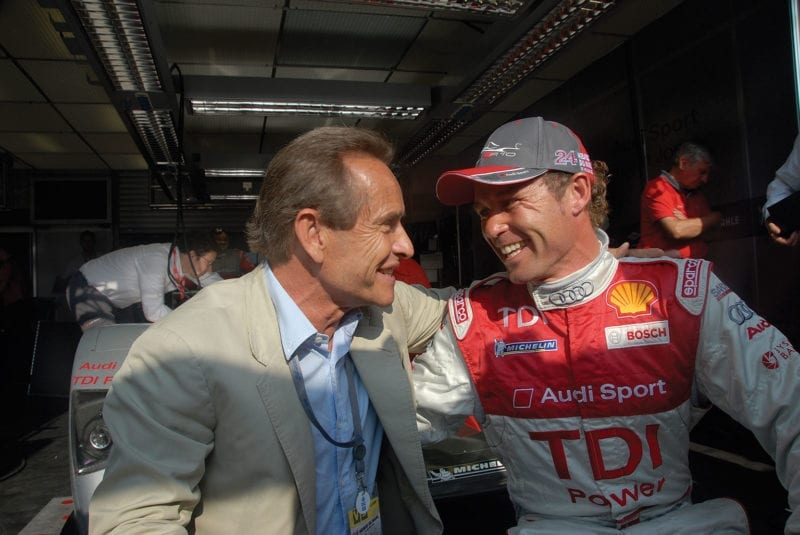
With Jacky Ickx, the man whose Le Mans win record he’s now beaten
Audi
BMW were back in 1999 with the radically revised V12 LMR. “In the week before Sebring we tested at Homestead, and we kept blowing differentials. Some of the team said we would have to go back to Europe, but the Williams mentality was: we’re here, we have Sebring in a few days, we’re going to sort it. They did, and we won the race, me, JJ Lehto and Jörg Müller – by 9.2 seconds after 12 hours. But Le Mans was the one that got away. It was a big year for manufacturers – Mercedes, Toyota, Nissan, Audi, BMW – and we led for most of the race. We were three laps in front after 19 hours and it was all looking good. But at Le Mans a small thing can always turn into a big thing. A damper unscrewed itself and pushed against a rollbar, which in turn jammed the throttle cable to one bank of cylinders. JJ was driving, and with half the V12 on full throttle he had a massive crash.
“A couple of months later I had my first meeting with Audi. Dr Wolfgang Ullrich, their head of motor sport, showed me a drawing of the R8, and we made a deal that day.” It was the start of a very fruitful relationship. Tom was also racing for Honda in the DTM and then the BTCC, and still got called upon for F1 tyre testing by Williams and Jaguar. But now, at 32, he realised that sports cars were his future. And, teamed with Emanuele Pirro and Frank Biela, he won the next three Le Mans races on the trot.
“The 2001 Le Mans victory is particularly unforgettable for me, because on April 25 that year we lost Michele.” Alboreto was killed during a pre-Le Mans test at the Lausitzring, when a rear tyre failure launched his R8 at more than 200mph into a series of cartwheels. “We respected Michele greatly, he won his final race at Sebring, and we felt him missing at Le Mans, we all thought about him. After his crash there had been a lot of talk about the danger of this type of racing. And Le Mans 2001 was wet. Endlessly wet. Heavy rain at Le Mans means you are constantly aquaplaning, because water lies in the indentations in the track. That year the 24 hours felt like a week. There were a lot of accidents, and driving slowly during all the safety car periods the cockpit filled up with water, up to your arms, like sitting in a bath. Because of the conditions, and all the safety car periods, we weren’t changing gear at full throttle, and that upset the transmission. In the end I lost fourth gear, so I chugged into the pits in fifth and, with less than four hours to go, they changed the gearbox. We still won by a lap. On the podium I felt completely empty, physically and mentally. Dr Ullrich said, ‘This one is for Michele’, and we all burst into tears. It was the most emotional Le Mans for me.
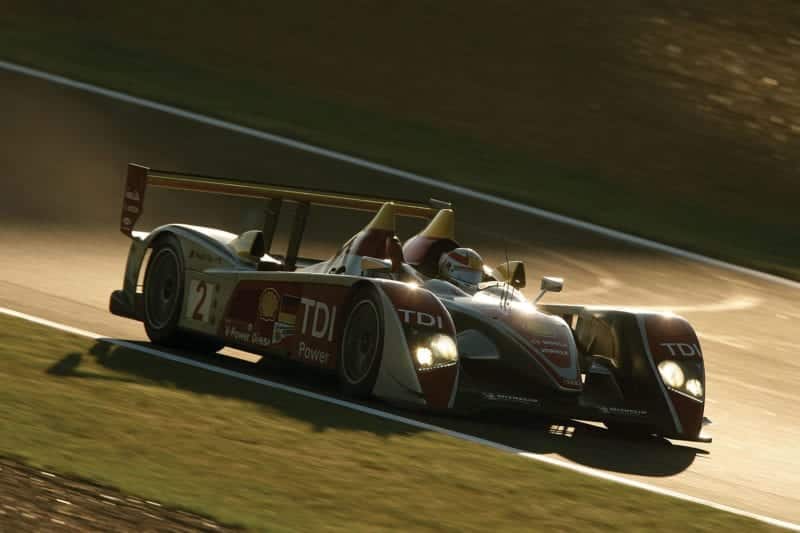
Tom, Allan McNish and Dindo Capello saw off the Peugeot challenge to win Le Mans in 2008 in Audi R10 turbodiesel
Audi
“In 2002, close to midnight, I had a right front puncture going into the Porsche Curves. A huge explosion, took out a lot of the front bodywork. I managed to get to the pits on three wheels, but I thought our race was gone – or, at least, we’d be in the pits a very long time. The mechanics were working on the right front, I was just sitting in the cockpit trying to be calm, and after about two minutes the chief engineer said, ‘Tom, be ready.’ The guy working on the right front caught my eye and put his thumb up. Then the engine was fired up and out I went. I’d been stationary about three minutes. I couldn’t believe it. We won the race, and the next morning when I looked at the car I realised there was a metre and a half of bodywork missing, back to the radiator.”
In 2003 there were no works Audis at Le Mans, so Tom was seconded to Bentley. With Dindo Capello, already a familiar partner from the ALMS, and Englishman Guy Smith he won again. “The Bentley was a closed car: better aerodynamics, but very little space inside, and very hot. In our open Audis there is heat from the side radiators, and the monocoque gets warm, but you’re breathing mainly clean air. In a closed car the air you breathe is really hot – they didn’t use air-con in race cars then. Running behind the safety car was almost unbearable, because at low speeds there was no airflow through the car. But for me the Bentley is still the most beautiful-looking Le Mans car ever.”
Tom won the 24 Hours again in 2004, with Dindo and Seiji Ara in a Japan Team Goh Audi R8, and in ’05 with JJ Lehto and Marco Werner in an American Champion Racing R8. He had now scored a quite astonishing six consecutive victories, and seven in all – beating Jacky Ickx’s long-standing record. For ’06 the Audi works outfit was back to debut its mould-breaking R10 TDI turbodiesel, and for the first time Tom was teamed with Allan McNish.
“Allan and I, we’d had a fantastic fight at Sebring in 2005. At the end, after 12 hours’ racing, we were separated by just over six seconds. A lot of it was in the strategy, short fuelling and tactic games. On the podium we agreed it would be cool to be in the same car. Dr Ullrich agreed to our request and, with Dindo, we’ve been together for five seasons now.”
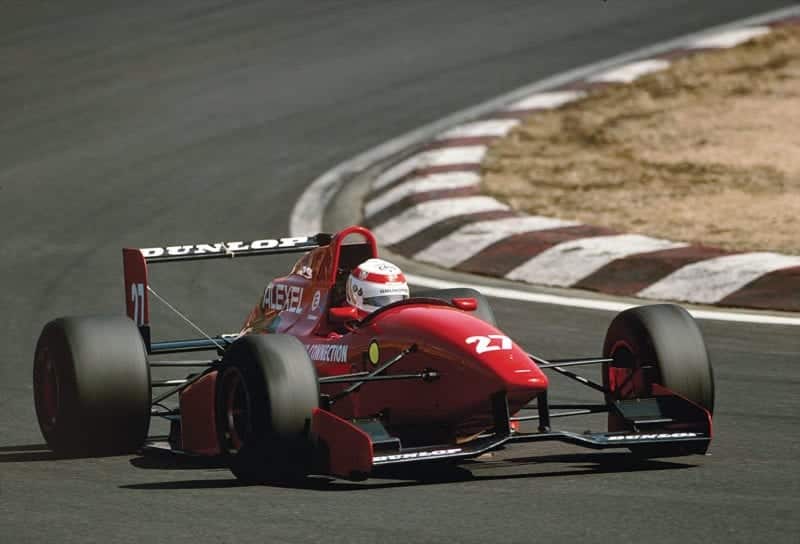
In Formula Nippon in 1994, he was runner-up in 1995
Motorsport Images
Tom, Allan and Dindo gave the R10 victory first time out, at Sebring, but at Le Mans Capello had an off avoiding a slower car. Delays to mend battered bodywork and replace a turbocharger left them a distant third. Then in April 2007, doing the DTM for Audi, Tom was involved in a horrifying high-speed pile-up at Hockenheim. His car was T-boned, reportedly generating forces of 63g. “I woke up in hospital feeling fine, because of all the adrenaline, but by Monday night I felt terrible. For a long time I was just unwell, with dizziness and headaches. That reduces your motivation to train. It took me two years to recover fully.”
Nevertheless at Le Mans that year things seemed back on script. “We were ahead almost from the start, and after 17 hours we had a lead of over 15 minutes. But at Le Mans the biggest lead can turn into the biggest disappointment. While Dindo was in the car on Sunday morning, he lost the left rear wheel and crashed.” Then came 2008, and a major onslaught from Peugeot, determined to end Audi’s winning streak.
“The Peugeots were basically quicker than we were, and everyone was waiting to see Audi get beaten at last. We were fighting the fastest Peugeot right up to the end, and we were on the same lap at the flag – but we were in front. That win really meant a lot, because it was so close-fought. For us it was a mega-triumph.” But in 2009 Audi did get beaten. The French cars finished 1-2, with Tom, Allan and Dindo only third, six laps down, after many problems with the new R15. “We’d won Sebring first time out with the new car, which created confidence. Then in the bad weather the radiators silted up, a problem we’d never had before. When you run those diesels out of the temperature range you have two choices: run with less power, or blow up the engine within one lap. So we ran with less power. Afterwards the whole Audi team went over and congratulated Peugeot. That evening the Peugeot guys were wearing Audi shirts, all completely out of their heads, with the Germans in Peugeot shirts.”
The days when Le Mans was more a test of reliability than outright speed are gone. This is now a flat-out sprint that happens to go on for a day and a night. “You have to be absolutely on it, all the time. But you must be intelligent about it. The car is very strong, but if you are clumsy with it you won’t get to the end of the race. You must use the kerbs, but you try to cross them with an unloaded wheel, like the inside wheel on the apex of a corner. When you ride an outside kerb coming out of a corner you’re doing it with a loaded wheel, which is more critical.
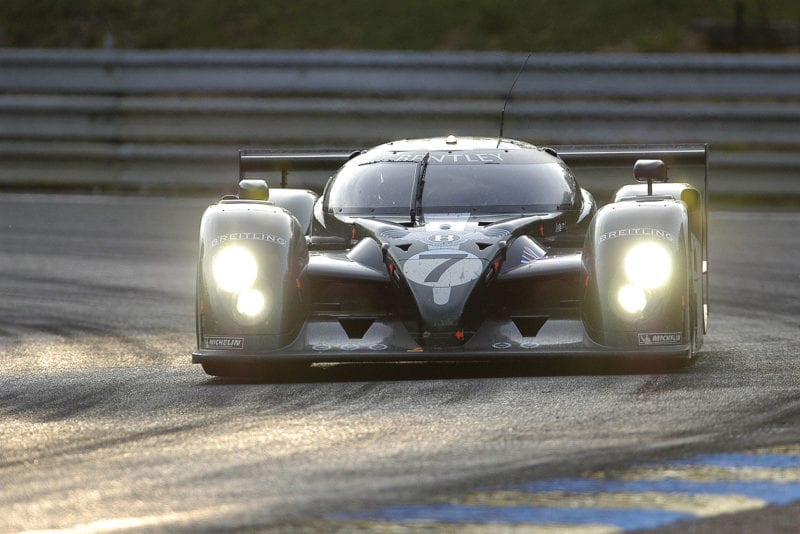
Bentley Speed 8 was “the most beautiful Le Mans car ever”
Bentley
“The key to being quick at Le Mans is how you deal with traffic. What matters is not your time over a single lap, it’s keeping your average up over a whole stint. This year, with the restrictors set by the current rules, we will be doing maybe 210mph. The GT2 Porsches and Ferraris will be doing about 180mph. But the speed difference isn’t the thing. It’s the braking difference. With their extra weight they will start to brake at, say, 170 metres. We will brake at 120 metres. So when they start to brake we are still flat out, and that’s where the danger is. You do touch other cars, it happens. If there are just two cars it’s usually not a problem, but sometimes three or four cars are running close together, all different speeds, different weights, different braking points. But that’s the challenge, that’s Le Mans.
“You have to read the traffic, because driving abilities vary. As you approach a car you can soon tell if there is a pro or an amateur at the wheel. You’re constantly making decisions: whether to sneak underneath him and scramble round the corner, using up a lot of brake and tyre, and maybe losing momentum, or whether to roll off the throttle a bit, hang back, get a higher exit speed from the corner, maybe a bit of a tow off him, and pass him on the next straight. Sometimes that can gain you half a second or more. Six or eight times every lap I have this dialogue with myself. Look at the lap times of the smaller GT2 cars and you’ll realise we are constantly in traffic. If you catch one on the straight, you’re lucky. If you get into somebody’s boot going into the Porsche Curves, it can cost you. There’s only one line there, unless you want to get onto the marbles, and that picks up on your tyres and loses you more. When you happen to get a clear lap, you produce a fantastic lap time. But you almost never get a clear lap.
“It can rain a lot at Le Mans, in the day, in the night. In the rain you’re still flat out on the Mulsanne, but your absolute speed is less because the wet tyres have more drag. Visibility is a problem, because the spray from 50 cars hangs trapped below the trees. For a lot of the time, in traffic, you’re driving totally blind. In 2001 we were only on dry tyres for five of the 24 hours. For the other 19 it was wets or inters. And, like I said, the aquaplaning…
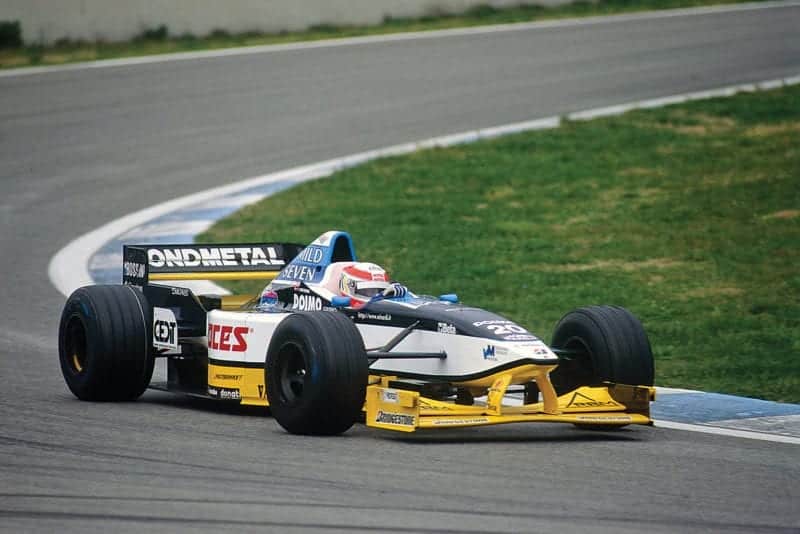
Formula 1 testing with Minardi
Motorsport Images
“With Allan and Dindo, we blend together well. Guys you’ve won Le Mans with, you have a bond. You do have disagreements with your co-drivers, maybe discussing the finer points of set-up, but I have so much respect for those two, and we work everything out between us. At Audi all nine drivers get precisely the same in terms of car and equipment, Dr Ullrich insists on that. Of course each driver wants his car to win, but we all share information. I can tell you, not all Le Mans teams are like that.
“Everybody’s goal has to be to maximise Audi’s chances of winning. In 2008, late in the race when we were fighting the Peugeots, it was raining on one side of the circuit and not the other. One of the Audis was several laps behind for various reasons, so it was used as a guinea pig: it was sent out on intermediate tyres to find out whether they were right for the conditions. Those guys helped us to win, because it’s the whole team that wins. If anybody isn’t a team player, or is just out for fame and fortune for himself, he doesn’t get asked back.”
On the Friday of the race weekend Tom makes a point of going into the spectator enclosures to meet some of the Danish fans. “It’s so friendly, and it motivates me. The Brits understand Le Mans, you guys have a whole culture of Bentley and Jaguar behind you, and I’m told in the good years about 50,000 go from the UK to watch. But the Danes are chasing you. My brother Jacob, who’s also a touring car racer, he runs a travel company. He says that about 25,000 of us make the trip south to the race now. It’s a festival. And with Allan and me in the same car, the Brits and the Danes mingle on the terraces and there’s a real party – although Allan says he isn’t a Brit, he’s a Scot!”
In January, playing badminton, Tom tore his left Achilles tendon, which compromised his fitness regime for a while. But, apart from some discomfort jumping in and out of the car during pitstops, he says he’s now as good as new. “I do a lot of cardio work – running, cycling with the racing bike, mountain bike work too, plus strength training. When I’m stuck in a hotel room I do exercises to work on my stamina. These cars are physical beasts to drive. We have paddle-shift now, of course, and power steering, but with the diesels we run a lot of downforce. You can’t afford to run too soft a brake pedal, because you want the brakes to last, so they’re set up with heavy pedal pressure. The clutch too: it’s only used at pitstops, but you need enough travel so that, at the end of a hard race, if it’s worn you can still get out of the pits.
“You try to optimise the traction control depending on conditions, temperature and particularly the state of the tyres. If you know you’re going long between tyre changes you’ll maybe adjust the traction control, to nurse the tyres. More traction makes more tyre heat, and tyre heat makes tyre wear. It’s a spiral.
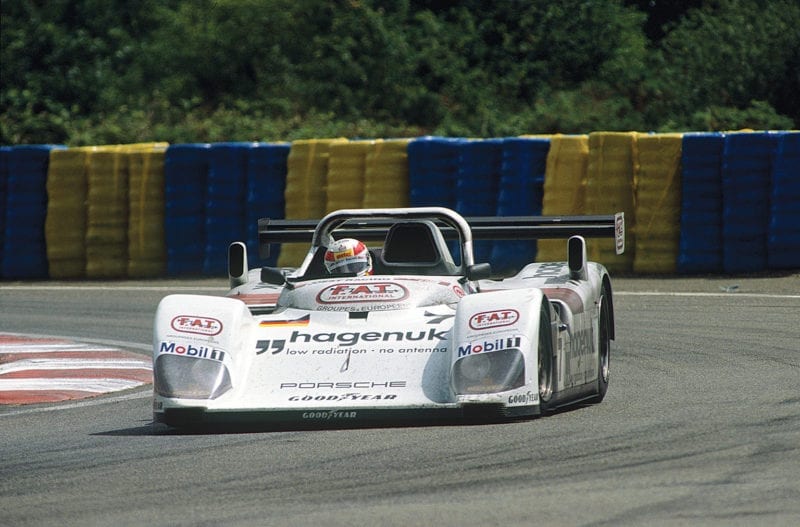
His winning Le Mans debut. The Porsche as shared with Alboreto and Johansson
Motorsport Images
“Our stints are normally 50 minutes between refuelling [the regulations restrict tankage to 81 litres]. A lot changed when the diesels came in, because with the extra torque and weight we sometimes struggle to keep the rear tyre durability over more than two stints. So they may leave the driver in for four stints, changing the tyres after the second stint, or they may change the driver and not the tyres. It’s all down to the tactics at the time, how the opposition is doing, how much rubber is on the track, the weather, the ambient temperature. But the driver has to know while he is out there what the plan is at that stage of the race, how many more stints he has to do, so he knows how to drive the tyres.
“Some say I talk a lot on the radio, but there are drivers who talk more than me. I talk when I get out of the car. Some drivers just say to the engineer, ‘It’s OK, it’s all good,’ and then walk away. On the radio I tell them things they need to know for the pitstop, and then after I’m out of the car I talk to the chief mechanic – I had to avoid a car here, I touched a bit too hard on the floor there. Things like that are easy to remember because they give you a scare. We have an event button on the steering wheel, and if you have a bad shift or maybe you hit a kerb too aggressively, you hit that button and say over the radio what it was. They can check the telemetry and take note of it, and then you can talk about it when you’re out of the car. If you’ve had a bad shift, for example, you can talk to the gearbox engineer, and he’ll say, that’s OK. Don’t worry. Or he’ll say, hmm, don’t do that again. From every single lap there are positives and negatives that you can pass on. It’s a constant process, because you’re not going to win the race unless you can keep the average speed over the 24 hours up around 135mph with all the stops. If you don’t do every single thing right, you’ll be too slow.
“After I’ve talked to the engineers and spoken to Ullrich and Jüttner I take a shower, get fresh underwear and overalls, go to the physio and they arrange some food if I want. I just want to calm down, but I don’t sleep for long, just small naps. At the start of my Le Mans career, when I wasn’t in the car I wanted to be in the pits all the time, like a kid in a candy store. Now I’m more relaxed, better at preserving energy. If I eat it will be a bit of pasta and tomato sauce, which is easy to digest, maybe yoghurt or a banana. And a lot of fluids, isotonic drinks. You lose weight during the race, of course, but you need to keep your fluid intake up. We don’t have a drinks bottle in the car, we just get a drink handed to us on a long pole during each refuelling stop.
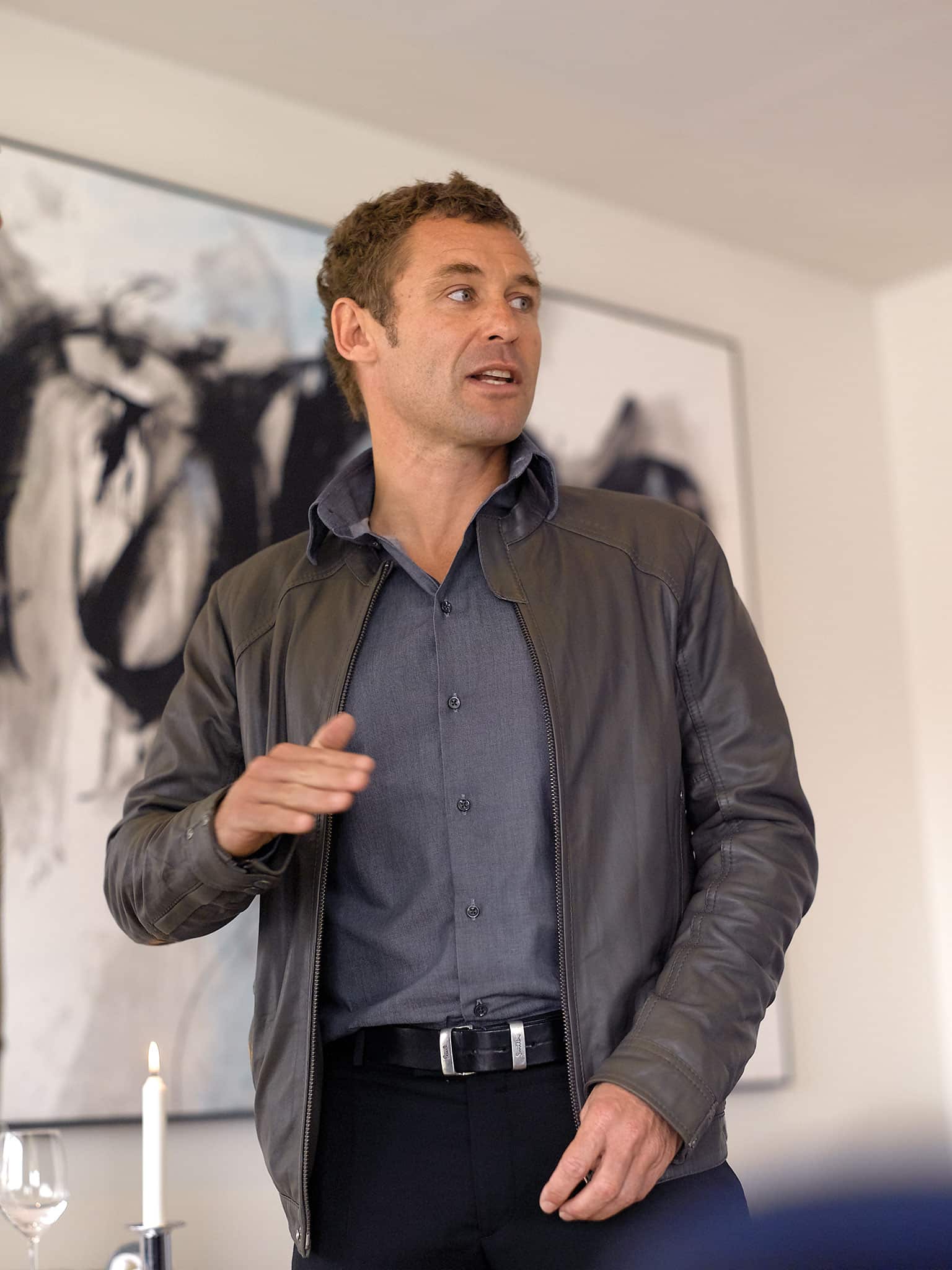
“Howden ‘H’ Haynes engineers my car. I’ve known H since he was a young data engineer at Bentley in 2003. His number two is Leena Gade, a very clever girl. We love working with her, love to wind her up. Then there are 10 mechanics for each of the three cars. Stefan Grimm is chief mechanic on our car. They are all Joest people. The operation is correctly named Audi Sport Team Joest: Joest is actually running the car, but there are Audi people on all three cars as well. On the engine side it’s Audi, so it’s a carefully worked out mix. You’d struggle to know who was from Audi and who was Joest.
“A driver’s working friendship with the mechanics should be automatic: if you have to think about the relationship, it’s already too late. But the older you get the more you have to work at it, because it comes more easily when you are a young driver and you are the same age as most of the mechanics. The people working in the pits have just the same passion to win, the same passion for motor sport, as the drivers do. A lot of them would have loved to race but didn’t get the opportunity. When we have kart races for fun, it’s always interesting to find that some of them are very quick.
“On Monday morning, if the race has gone well, you wake early, still full of adrenaline, and breakfast tastes wonderful. I always go back to the circuit because the guys are all there packing up, and I like to say thank you to all of them, for everything. If the race hasn’t gone well you feel different, but I still want to say thank you.”
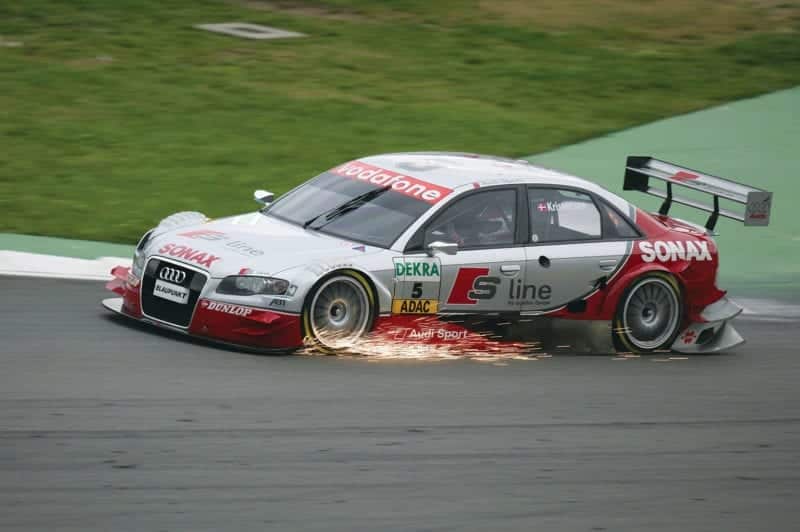
At the wheel of an Audi DTM racer in 2005
Motorsport Images
So to this year, and at 3pm French time on June 12 the titanic Peugeot-Audi battle will be joined once more. “Peugeot wants to be sure they win again. And Audi wants to get back to winning. Both teams have very strong line-ups. Peugeot have a new car – they say they have the old car, but they have a new car every year. We have a new car – we call it the R15 Plus, because we’ve changed a lot of things, optimised everything.
“Le Mans is like nothing else in motor racing. It’s a different challenge. There are no excuses, only explanations. All you can do is respect it, and try to do better. It’s going to be a fantastic race.”
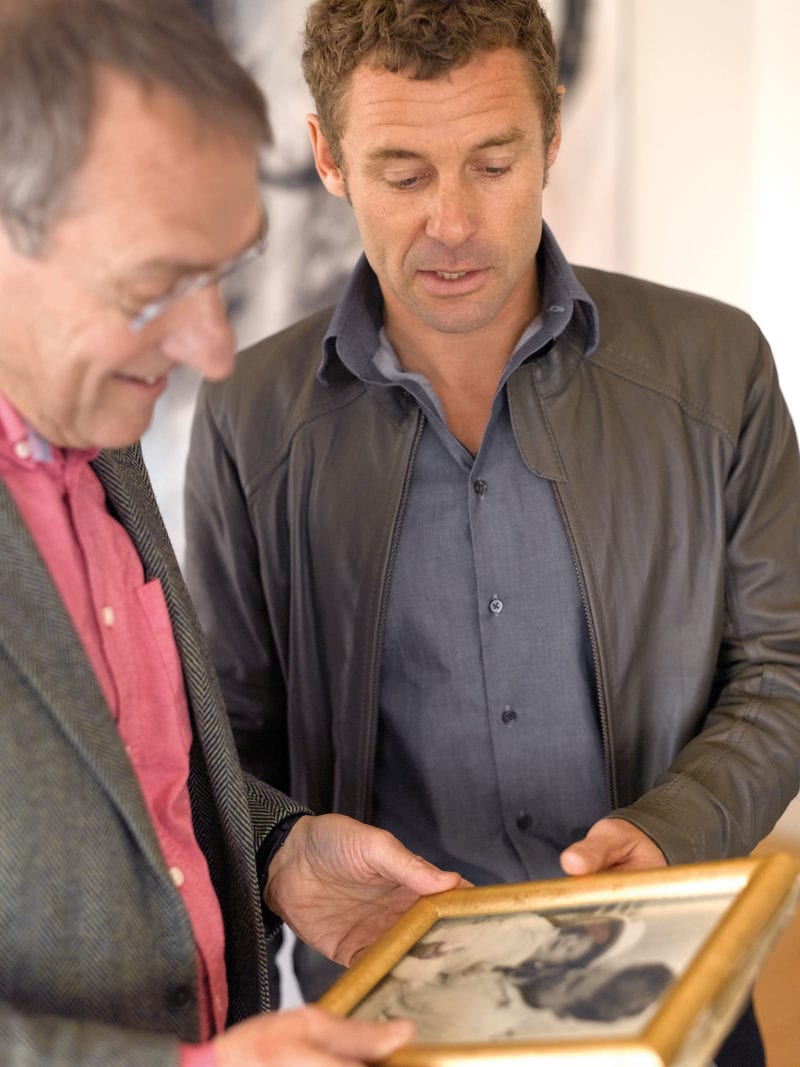
This photo is of Carl-Erik Kristensen, whose son absorbed his passion for racing
